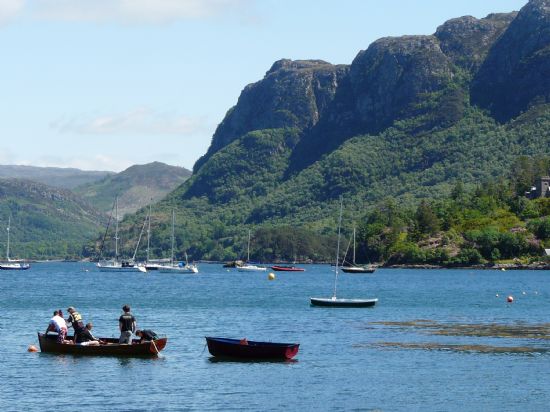Natural History
Geology
The main rock type around Achmore and Stromeferry is Lewisian gneiss, which is the oldest rock type in Scotland, dating from 2,600 million years ago. These rocks have been severely eroded and weathered, and the sediments from this were deposited when the area was under water, forming the Torridonian sandstone which predominates in the western part of Lochalsh, and forms Craig Dullach, (Duilisg) west of Srath Ascaig. The immense forces that the gniess has been subjected to over these years are visible in the bends and stretches in the rock layers that you see in exposed rock in some road cuttings.
There is a major fault line running down north west Scotland from Loch Eriboll to Sleat in Skye, known as the Moine Thrust, and it runs through the local area from Strome Ferry, across Srath Ascaig just east of Achmore, and southward over Beinn Raimh (for Geological Map of Wester Highlands, click here www.es.ucl.ac.uk/undergrad/fieldwork/image/assynt/assynt/struct.htm)
This is where Moine rock to the east has been pushed over the western rocks. This action has involved huge forces of pressure and friction, bending, crushing, stretching and turning over rocks, action which has created new rock types such as the blue green talc schist visible in the road cutting at the top of Auchtertyre hill. This talc also occurs at Ardintoul, across Lochalsh, where it was mined during the first half of the twentieth century, for soap manufacture and other products.
As part of this process rocks on both sides of the narrows of Loch Carron and Craig Dullach have been turned right over so that the older gneiss is now above the more recent sandstone.
The Moine thrust line is also associated in various places along it’s length with limestone outcrops, notably at Durness, Kishorn, and Sleat, giving a soil less acidic than surrounding areas, and this may be the reason for the presence of ash trees (which prefer a more alkaline soil) between Achmore and Braeintra.
There have been several periods of glaciation in Scotland, the last one finishing about 8,000 BC. These have resulted in various changes in sea level, producing raised beaches such as the one on the west side of Craig Mhaol, above Portachuillin.
Carn a'Bhealaich Mhoir SSSI
Grid reference: NG 826 324, area 39.2 hectares. This is a geological Site of Special Scientific Interest, above Craig, where the TV mast is. This is the description from Scottish Natural Heritage:
"The Kishorn Nappe is the lowest of three thrust units which make up the Moine Thrust Zone in the Lochalsh district. It comprises Torridonian and Lewisian rocks which lie on the upside down limb of a major fold called the "Lochalsh Syncline". The site is a key locality within the Thrust Zone because the original nature of the boundary which separates the younger Torridonian rocks from the older Lewisian lithologies can be proved to have been a surface of erosion and as such represents a considerable geological time-gap. The importance of this site lies in its significant contribution to a comprehensive undertaking of the complicated sequence of events within the Moine Thrust Zone, providing as clear exposition of what is interpreted as the earliest phase - the mylonite formation from both Torridonian and Lewisian rocks, developed along the inverted, sheared erosion surface."